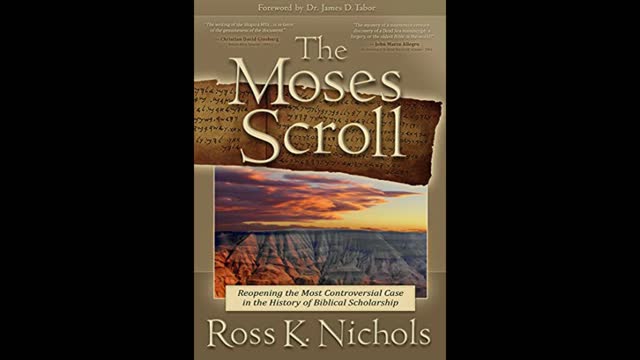Premium Only Content

The Moses Scroll with Ross Nichols
In 1878, a Jerusalem antiquities dealer named Moses Wilhelm Shapira acquired a curious biblical manuscript consisting of sixteen leather strips. The manuscript, written in ancient, Paleo-Hebrew contained what appeared to be a form of the Bible’s Book of Deuteronomy but with significant variations. It was allegedly discovered by Bedouin tribesmen around 1865, east of the Dead Sea, in a remote cave, high above the Wadi Mujib (biblical Arnon). Shapira believed that his manuscript was both ancient and authentic. In 1883, he presented his scroll to the leading scholars of Europe. Newspapers around the world covered the unfolding story as scholars debated the genuineness of the leather strips. Ultimately the scroll was deemed a forgery and Shapira the forger. However, beginning in 1947, ancient scrolls discovered in the Qumrane cavs near the Dead Sea lead us to ask—were the critics wrong? The Moses Scroll documents the details of the entire saga based upon what we know today including a chronological telling of the fascinating story based upon 19th-century reports; an assessment of the genuineness of Shapira’s scroll; a new transcription of the manuscript as seen through the eyes of the 19th-century’s best Hebraists; and the author’s own translation of the original sixteen leather strips with a commentary and notes.
Ross K. Nichols is a researcher, writer, educator, and author of The Moses Scroll and a popular blog related to emerging Shapira research. He has traveled extensively to Israel over the past decade and participated in archaeological excavations in Jerusalem and at Biblical Tamar south of the Dead Sea, where he has mapped and surveyed the desert regions of the Negev associated with biblical narratives
-
 LIVE
LIVE
Gatoroz
3 hours agoTake Me Back To Verdansk
58 watching -
 LIVE
LIVE
STGKAMZZ
4 hours ago"🔥Blunt & Battle: Chill Vibes Only in COD Ranked! 🌼💨 Spring Saturdays Just Got Epic!"
76 watching -
 34:00
34:00
Tactical Advisor
2 hours agoRetiring This Rifle | Vault Room LIve Stream 019
17.6K8 -
 16:29
16:29
Sideserf Cake Studio
4 hours ago $1.77 earnedThis Cruise Ship Is A CAKE!
11.8K4 -
 14:49
14:49
Clownfish TV
19 hours agoNintendo Switch 2 BACKLASH! Gamers BOYCOTT Over Pricing?!
8.68K7 -
 24:17
24:17
JasminLaine
19 hours agoCTV Reporter DESTROYS Carney By Quoting His BOOK—His INSANE Answer STUNS Host
11.5K22 -
 24:47
24:47
World2Briggs
1 day ago $1.04 earned10 Cities Where The High Cost Of Living Just Isn't Worth It
7.46K5 -
 LIVE
LIVE
SoundBoardLord
3 hours agoSaturday Variety Gaming with Friends!!
145 watching -
 8:35
8:35
ARFCOM News
23 hours ago $0.28 earnedThis Is How We End The NFA | Booker's Hypocrisy | ATF Facial Recognition
6.85K4 -
 10:51
10:51
IsaacButterfield
1 day ago $0.65 earnedToddler Expelled From School For Being “Transphobic”
8.86K8